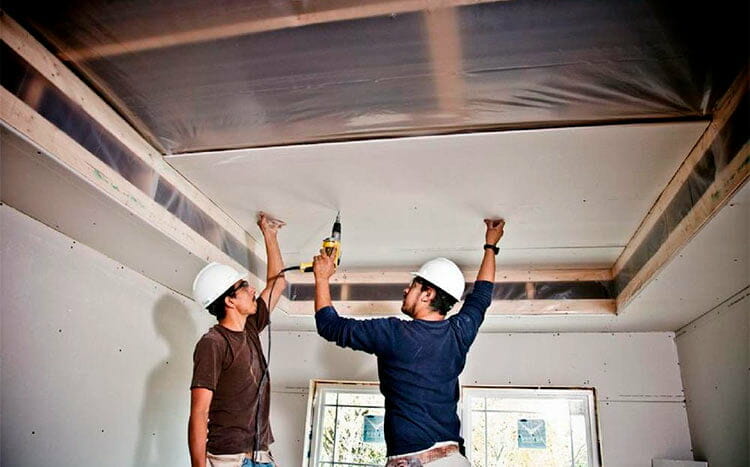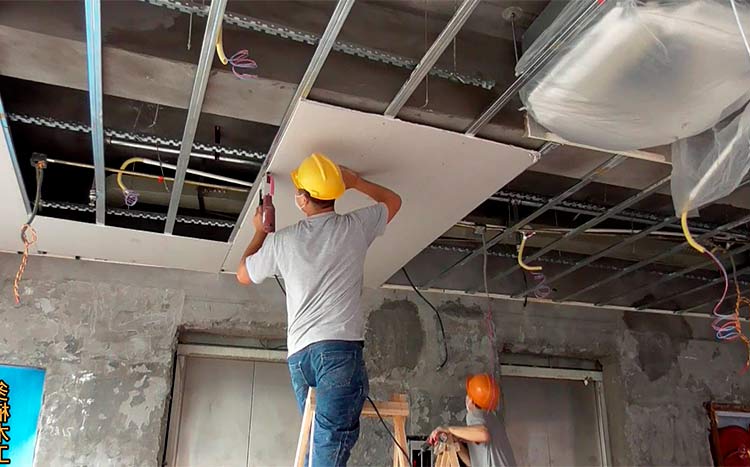From the 1930s to the 1980s, hazardous asbestos was commonly utilized in joint or mud compounds during the installation of drywall and sheetrock. Residing in a property that includes this substance may result in accidental exposure and pose potential health risks for the inhabitants, both presently and moving forward.
Asbestos present in old drywall and sheetrock should be removed safely by a professional to prevent accidental exposure. Most homes built in the early to mid-nineties have asbestos in the drywall or sheetrock. Using today’s technology and expertise, experts can inspect, detect and remove dangerous asbestos in your house safely. You cannot identify or remove asbestos on your own without risking exposure.
What we cover
ToggleHow Common Is Asbestos in Plaster/ Drywall?
It’s quite common to find asbestos embedded in the mud or joint compound in plaster or drywall for houses that are more than a decade old. Nearly all drywall or sheetrock installed in this period had some asbestos as part of the compounds for insulation and other purposes. Asbestos dangers had not been identified then and it was a readily available material. As a result, millions of people could be living in houses with asbestos on interior walls without being aware of it.

Here are some of the areas you are most likely to find asbestos in your home in addition to interior drywall:
Interior spaces
- In the bathroom, toilet, and laundry cement sheet walls, backing to wall tiles, ceilings, and walls
- In drywall as part of the mixture or joint compound
- Cement sheeting in plaster walls- was added to plaster walls in the past to provide extra insulation and as a fire retardant.
- Beneath wood-heater hearths and insulation
- In kitchen splashback, between floor tiles, ceilings
- Living area ceilings, walls, insulation, and tiles
- Inside roof and attic cavities
- Inside ironing-board covers, plaster sealant, hot water pile insulation, electrical meter backing fibreboard wall panels, etc.
Exterior spaces
- Perimeter fences
- Carports
- Dog Kennel drywall
- Buried construction waste
- materials on the yard
- Roof sheeting
- Ridge capping
- Brick cladding etc.
An inspection carried out by a professional home improvement expert can identify the presence and amount of asbestos in your drywall, sheetrock, and other areas in your home. Bear in mind that any amount of asbestos in your home is unsafe and should probably be removed safely without risking accidental exposure to you and your loved ones.
Asbestos was mostly mixed with other compounds such as cement when it was used to reinforce drywall and other installations This makes it virtually impossible to identify the dangerous compound on your own through any DIY tests.
While there is a high likelihood that you have it in your drywall or sheetrock, only a professional inspection can confirm its presence through a range of chemical tests. Also, keep in mind that asbestos in drywall is generally safe unless disturbed either through physical impact or wear and tear which is quite possible in old houses. During renovations or repairs, be sure to have an inspection done for asbestos.
Cost to Remove Asbestos Drywall?
On average, you should expect to pay between $1,000 to $2,000 to have asbestos removed from your drywall during renovations.
The table below outlines some of the amounts you might pay to have asbestos removed.
| Item (Asbestos removal from drywall) | Low | High |
|---|---|---|
| Average cost | $1000 | $2000 |
| Hourly rate to remove asbestos in drywall | $75 | $185 |
| Brown asbestos removal | $345 | $500 |
| Blue Asbestos removal | $500 | $1000 |
| Whole House Asbestos remediation | $10,000 | $16,500 |
| Asbestos disposal costs per cubic yard | $10 | $50 |
These are just estimations. Do the following to get quick real quotes from professional asbestos removal experts in your location.
- Scroll to the top of the page and enter your Zipcode
- Answer questions about what you want to be done
- The information you enter will be forwarded to three local experts. They will send you a price estimate for the job and some friendly advice
IMPORTANT: There is no obligation to hire. This is a free tool and service to be used at your pleasure

The amount you pay to have asbestos removed varies depending on where it is located, the surface area, type of asbestos, and other factors such as:
- Your location – hourly rates vary from one location to another depending on local taxes and other factors.
- Type of building – is it a residential or commercial building
- Type/brand of asbestos – toxicity levels and ease of removal vary from one brand of asbestos to another.
- Room/ wall location – is the drywall in easy-to-access areas like living rooms or bedrooms. Difficult areas like an attic or basement will cost more.
- Surface area – This determines the amount of work and number of hours. Most asbestos removal services will be charged based on an hourly rate. The national average hourly rate for asbestos removal ranges between $75 to $185.
In most cases, asbestos removal will be done as part of a larger project like renovation or wall repair. This means the actual service of removing asbestos (which is often necessary) will be included in the renovation quote. However, you can still get an order for asbestos removal services on their own for your safety if you own an old house as the risk of exposure through normal wear and tear is quite high.
Should I Have Asbestos-Ridden Sheetrock Removed?
It’s advisable to have asbestos-ridden sheetrock removed to prevent accidental exposure due to wear and tear or cracks and scratches. In most cases, any sheetrock that has asbestos in it is more than three decades old and therefore quite prone to wear and tear therefore risking exposure to occupants. Of course, asbestos-ridded sheetrock that is in good conditions is quite safe so long as it remains undisturbed.
Another reason or instance where it is necessary to have old asbestos-ridden sheetrock removed is when you are doing some repairs or renovation on your house. Make sure that you have your walls inspected by an asbestos expert beforehand for safety purposes. Some home improvement experts may not be aware of the dangers of working with asbestos and may be exposed while working.

When Did They Stop Putting Asbestos in Drywall?
The dangerous compound has not been used in drywall since the 1980s (late 80s) after the building boom that came after the world wars. Asbestos was a popular compound added to drywall in the early to mid-nineties due to its availability and desirable quality at the time.
However, it was later discovered that workers who used asbestos in construction projects and were exposed got seriously ill from liver-related issues. Today, asbestos is not used in drywall because of its dangers but it remains in old buildings and houses still in use today.
Can I Seal Asbestos Drywall with Paint?
Asbestos forms a strong bond with other materials used in drywall and is present in large quantities. Covering it with a layer of paint is a temporary solution which is not ideal especially for old drywall that is breaking apart. Over time, the underlying compounds that include toxic asbestos will disintegrate therefore risking exposure to occupants. The best solution is to have the asbestos drywall torn down and replaced safely.
Can I Test for Asbestos in Drywall?
It is impossible to DIY test for asbestos presence in your drywall if you don’t have the skills, testing equipment, and chemicals to conduct the tests. Experts trained to test for such compounds in homes have these tools and expertise to do the necessary tests needed to detect and measure the amount and condition of asbestos in your drywall. The test will include, among other things:
- Visual tests
- Chemical tests to determine the type, condition, and age of asbestos
- Locating the asbestos in your drywall.
Will I Die from Asbestos in My Drywall?
The chances of dying because you have asbestos in your drywall are quite low. However, the risk of accidental asbestos exposure will remain present so long you have that old drywall in your building or home. Asbestos embedded in drywall and still structurally sound is quite safe. However, old age, physical impact, normal wear and tear, repairs may lead to the dangerous substance being released.
The health risks associated with asbestos exposure are quite serious. According to the CDC, asbestos embedded in internal organs like the lungs can cause some cancers, tumors, and liver conditions that are terminal. Weighing these risks and the cost of having the substance replaced, most homeowners would prefer the latter option.












